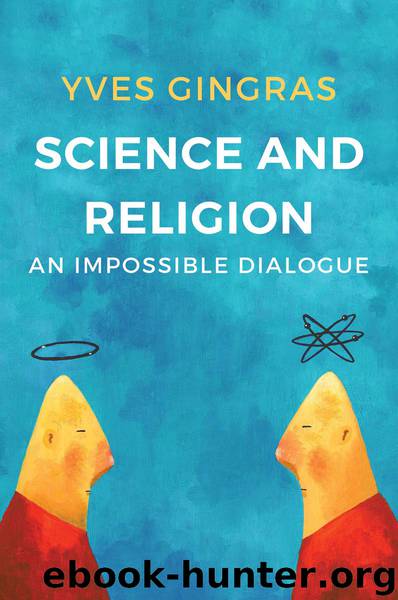Science and Religion by Gingras Yves;

Author:Gingras, Yves;
Language: eng
Format: epub
Publisher: Polity Press
Published: 2017-06-19T00:00:00+00:00
For unknown reasons, the Inquisition did not follow up on the anonymous whistleblower’s complaint.33 At the same time, however, the Faculty of Theology of the Sorbonne, with the support of the Parliament of Paris, prohibited public discussion of fourteen ‘theses’ that opposed the philosophy of Aristotle, including those promoting atomism and gave the authors of the theses twenty-four hours to leave Paris.34 In 1632, an internal regulation of the Jesuits order also prohibited the teaching of atomistic ideas in their colleges and schools.35 Following the work of the priest Pierre Gassendi, which proposed an interpretation of atomism acceptable for Catholics – in much the same way as Thomas Aquinas had Christianized Aristotle – and the dissemination of Descartes’ philosophy in the middle of the century, the question of the conflict between atomism and theology became much discussed among philosophers. In 1658, a philosophical essay printed in Rome reminded its readers that the ‘opinion denying generally that accidents are separate from corpuscles presents a difficulty from the perspective of faith and of the Eucharistic mystery’.36 And even though Descartes clearly denied believing in atoms and claimed instead that matter was infinitely divisible, his concept of ‘corpuscles’ was most often understood as consistent with atomistic theses and associated with the denial of the reality of accidents.37 His works, including his Principles of Philosophy that contains his physics, had, moreover, been placed on the Index – subject to some corrections as had been the case for Copernicus – in 1663.38 The hostility to atomism would ultimately be reflected in a decree of the Inquisition in 1673 ordering the local inquisitors to refuse the ‘imprimatur’ to works supporting this doctrine.39 But unlike heliocentrism, the Church never went so far as to officially condemn the doctrine by placing already published books on the Index and sought merely to curb its dissemination. Even in the middle of the eighteenth century, the Congregation of the Index bothered the Neapolitan theologian Antonio Genovesi, author of a metaphysical treatise that was too eclectic for the Church, by sending him a list of thirty-four corrections to be made, including one on atomism because it was presented as compatible with Christian doctrine.40
If, in the end, atomism managed to impose itself in chemistry and physics at the beginning of the twentieth century, the question of the nature of substances remained problematic at the theological level. As late (or as recently …) as 1950, in his Encyclical Humani Generis, Pius XII still felt obliged to recall that too many errors ‘have crept in among certain of Our sons who are deceived by imprudent zeal for souls or by false science’. He felt compelled ‘with grief to repeat once again truths already well known, and to point out with solicitude clear errors and dangers of error’. Among these truths worth repeating we find the scholastic concept of substance, which continued to be necessary because the atomic theory remained of course incompatible with the dogma of transubstantiation. The Pope therefore called to order those who
Download
This site does not store any files on its server. We only index and link to content provided by other sites. Please contact the content providers to delete copyright contents if any and email us, we'll remove relevant links or contents immediately.
Enlightenment Now: The Case for Reason, Science, Humanism, and Progress by Steven Pinker(6871)
A Journey Through Charms and Defence Against the Dark Arts (Harry Potter: A Journey Through…) by Pottermore Publishing(4722)
The Immortal Life of Henrietta Lacks by Rebecca Skloot(4253)
A Journey Through Divination and Astronomy by Publishing Pottermore(4248)
Elon Musk by Ashlee Vance(3854)
Origin Story: A Big History of Everything by David Christian(3471)
COSMOS by Carl Sagan(3346)
Alchemy and Alchemists by C. J. S. Thompson(3293)
Enlightenment Now by Steven Pinker(3271)
Shadow of Night by Deborah Harkness(3173)
Inferior by Angela Saini(3148)
A Mind For Numbers: How to Excel at Math and Science (Even If You Flunked Algebra) by Barbara Oakley(3102)
Bad Pharma by Ben Goldacre(3094)
Origin Story by David Christian(2991)
Signature in the Cell: DNA and the Evidence for Intelligent Design by Stephen C. Meyer(2875)
The Code Book by Simon Singh(2855)
The Elements by Theodore Gray(2851)
A Brief History of Time by Stephen Hawking(2819)
A Journey Through Potions and Herbology (A Journey Through…) by Pottermore Publishing(2772)
